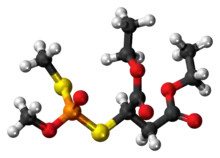 | |
 | |
| Names | |
|---|---|
| Preferred IUPAC name
Diethyl {[methoxy(methylsulfanyl)phosphoryl]sulfanyl}butanedioate | |
| Other names
S-Methylmalathion | |
| Identifiers | |
3D model (JSmol) |
|
| ChemSpider | |
PubChem CID |
|
| UNII | |
CompTox Dashboard (EPA) |
|
| |
| |
| Properties | |
| C10H19O6PS2 | |
| Molar mass | 330.36 g/mol |
Except where otherwise noted, data are given for materials in their standard state (at 25 °C [77 °F], 100 kPa).
Infobox references | |
Isomalathion is an impurity found in some batches of malathion. Whereas the structure of malation is, generically, RSP(S)(OCH3)2, the connectivity of isomalathion is RSPO(SCH3)(OCH3). It arises by heating malathion. Being significantly more toxic to humans than malathion, it has resulted in human poisonings.[1]
In 1976, numerous malaria workers in Pakistan were poisoned by isomalathion.[2] It is an inhibitor of carboxyesterase.
References
- ↑ Rengasamy, S.; Parmer, Balraj S. (1988). "Investigation of some factors influencing isomalathion formation in malathion products". Journal of Agricultural and Food Chemistry. 36 (5): 1025–1030. doi:10.1021/jf00083a030.
- ↑ Baker EL, Warren M, Zack M, et al. (1978). "Epidemic malathion poisoning in Pakistan malaria workers". Lancet. 1 (8054): 31–4. doi:10.1016/S0140-6736(78)90375-6. PMID 74508. S2CID 24973326.
This article is issued from Wikipedia. The text is licensed under Creative Commons - Attribution - Sharealike. Additional terms may apply for the media files.